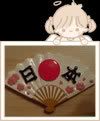
 よしみのプロフィール よしみ大好きドラマ歌曲 よしみ好きなもの  The Lord The Lord Pink, Black, Grey & Brown Color Pink, Black, Grey & Brown Color Japanese Food,日本料理 Japanese Food,日本料理 Jap Language,日本語 Jap Language,日本語 Blogging Blogging Watch Japan Hour Watch Japan Hour Baking, Cooking Baking, Cooking Running Running Traveling & Fotos taking Traveling & Fotos taking See & feel snow, 雪大好き See & feel snow, 雪大好き Delicious Dessert Delicious Dessert 苺、蜜柑、林檎。。 苺、蜜柑、林檎。。 魚、野菜。。 魚、野菜。。 Trueful friends Trueful friends A Trip to Melbourne again A Trip to Melbourne again A Trip to Sydney A Trip to Sydney       Web Design Course Web Design Course    Being 日本語翻訳家 Being 日本語翻訳家  Gain Overseas Work Experience Gain Overseas Work Experience  Go for church camp Go for church camp Complete full marathon race Complete full marathon race   Agnes B Sunglasses Agnes B Sunglasses Dazzling Necklace Dazzling Necklace  Japan Flip Phone Japan Flip Phone New Watch from Seiko New Watch from Seiko   日本->Aomori 日本->Aomori   日本->Fukushima 日本->Fukushima 日本->Furano 日本->Furano       日本->Kagoshima 日本->Kagoshima   日本->Nagano 日本->Nagano 日本->Nagasaki 日本->Nagasaki 日本->Nikko 日本->Nikko  日本->Nigatta 日本->Nigatta  日本->Otaru 日本->Otaru 日本->Okinawa 日本->Okinawa         日本料理法  By Setsuko Yoshizuka By Setsuko Yoshizuka
 By Masanori Kitagawa By Masanori Kitagawa
 Tokyo Food Page Tokyo Food Page
 Bunka School Recipes Bunka School Recipes
 Japanese Cusine Japanese Cusine有用な旅行工具  Budget Japan Travel Stay ~ Toyoko Inn Budget Japan Travel Stay ~ Toyoko Inn
 Asia Room Booking Asia Room Booking
 Zuji Online Travel Guru Zuji Online Travel Guru
 att-japan travel guide att-japan travel guide
 Japan Rail Pass Japan Rail Pass
 日本遊覧客全国 Japan National Tourist Org 日本遊覧客全国 Japan National Tourist Org
 よこそ Yokoso! JapanWeeks Jan.20-Feb.28 よこそ Yokoso! JapanWeeks Jan.20-Feb.28
 Japan Travel Guide Japan Travel Guide Blog frm 14Feb06 to 31May08 Blog frm 14Feb06 to 31May08 May 2008 May 2008 June 2008 June 2008 July 2008 July 2008 August 2008 August 2008 September 2008 September 2008 October 2008 October 2008 November 2008 November 2008 December 2008 December 2008 January 2009 January 2009 February 2009 February 2009 March 2009 March 2009 April 2009 April 2009 May 2009 May 2009 June 2009 June 2009 July 2009 July 2009 August 2009 August 2009 September 2009 September 2009 October 2009 October 2009 November 2009 November 2009 December 2009 December 2009 January 2010 January 2010 February 2010 February 2010 March 2010 March 2010 April 2010 April 2010 May 2010 May 2010 June 2010 June 2010 July 2010 July 2010 August 2010 August 2010 September 2010 September 2010 October 2010 October 2010 November 2010 November 2010 December 2010 December 2010 January 2011 January 2011 February 2011 February 2011 March 2011 March 2011 April 2011 April 2011 May 2011 May 2011 June 2011 June 2011 July 2011 July 2011 August 2011 August 2011 October 2011 October 2011 |
A visit to Singapore Peranakan Museum
Friday, September 10, 2010
11:56 PM Today is a Public Hoiliday which is a Hari Raya - New Year for the Malays. Thanks to them that we can have a day off from work =) We met up with Yuko san first to have lunch together and although the plan was to have frog porridge for lunch but who knows the shop had already closed down, hence we find alternative nearby & come across this Chinese Restaurant on which we Thank God that the arrangement was actually great as they served great food! Simply delicious!!! All of us enjoy all the tim sums we ordered, please see pictures below:-  
MINITURES FOUND AT SOUVINEAR SHOP OF PERANAKAN MUSEUM: Tea Break @ Coffee & Toast Citylink Mall after our Museum visitation, some pictures of what we had:- More information:- Opening hours: 1pm to 7pm on Monday, 9am to 7pm from Tuesday to Sunday. Website: http://www.peranakanmuseum.sg/ [Extract from Internet info] History of Peranakans:- Our Roots The word “Peranakans” meaning “descendents” is colloquially used to refer to the descendents of the early Chinese community that settled in the Malay Archipelago around the 17th Century. Also known as “Babas” (the males) or “nonyas” (the females), they are typically of mixed parentage (between the Chinese men and native women), as Chinese women were restricted by law from leaving the main land (China) until sometime in the 19th Century. These communities lived and engaged in trade within the Straits settlements of Singapore, Malacca, Penang and even Dutch-controlled Java resulting in another name being commonly used to describe them – the “Straits Chinese”. Our Culture The Peranakan culture has evolved over the centuries into a unique blend of customs and traditions with traces of Portuguese, Dutch, British, Malay, Indonesian and Chinese influences. This includes their own pidgin language – mixture between “Bahasa Malayu” (the native language of the indigenous people of the region) and various Chinese dialects such as “Hokkien” – and of course the world’s most universal language – Food! Our Food Peranakan food involves a unique fusion of both Chinese and Malay elements (It is Chinese in that it retains the use of ingredients such as pork and it is Malay in that it uses malay styles of cooking as well as Malay spices or rempah in all its various dishes). True Peranakan recipes are complicated affairs, requiring hours of preparation – cutting, chopping, skinning, pounding and grinding of raw, local Malay home-grown garden-produce ingredients like lengkuas, assam, bawang, cabai, serai, cukur, daun pandan and santan. Common cooking methods adopted from the Malays included panggang (smoke), goreng (fried), tumis (lightly fried) or rebus (boiled). Peranakan recipes are usually spicy, employing pungent roots like lengkuas (galangal), turmeric and ginger; aromatic leaves like daun pandan (screwpine leaf), daun limau purut (fragrant lime leaf) and daun kesum (polygonum or laksa leaf); together with other ingredients like candlenuts, shallots, shrimp paste and chilli. Lemon, tamarind, belimbing (carambola) or green mangoes are used to add a tangy taste to many dishes. The Peranakans are also renowned for their scrumptious and colourful cakes and sweet, sticky delicacies to end the meal. Nonya kueh or cakes are rich and varied, made from ingredients like sweet potato, glutinous rice, palm sugar and coconut milk. Do check the website for more further if you are interested to know about Peranakans. Labels: Daily ~ 毎日何おします?, Delicious Food ~ 美味しい料理, Singapore Event~シンガポレできこと  主の恵みわたしたち有難いです! 主の恵みわたしたち有難いです!
|
ブログコメント マラソンを参加する           03.07.11 Great Eastern 10km Run 03.07.11 Great Eastern 10km Run 28.05.11 Sundown 21km Run 28.05.11 Sundown 21km RunMy Links 
 |


















